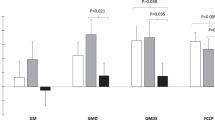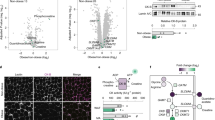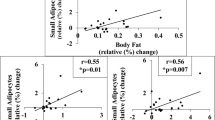Abstract
BACKGROUND/OBJECTIVES:
Although adipose tissue (AT) hypoxia is present in rodent models of obesity, evidence for this in humans is limited. Here, we investigated the effects of diet-induced weight loss (WL) on abdominal subcutaneous AT oxygen tension (pO2), AT blood flow (ATBF), AT capillary density, AT morphology and transcriptome, systemic inflammatory markers and insulin sensitivity in humans.
SUBJECTS/METHODS:
Fifteen overweight and obese individuals underwent a dietary intervention (DI), consisting of a 5-week very-low-calorie diet (VLCD, 500 kcal day−1; WL), and a subsequent 4-week weight stable diet (WS). Body composition, AT pO2 (optochemical monitoring), ATBF (133Xe washout), and whole-body insulin sensitivity were determined, and AT biopsies were collected at baseline, end of WL (week 5) and end of WS (week 9).
RESULTS:
Body weight, body fat percentage and adipocyte size decreased significantly during the DI period. The DI markedly decreased AT pO2 and improved insulin sensitivity, but did not alter ATBF. Finally, the DI increased AT gene expression of pathways related to mitochondrial biogenesis and non-mitochondrial oxygen consumption.
CONCLUSIONS:
VLCD-induced WL markedly decreases abdominal subcutaneous AT pO2, which is paralleled by a reduction in adipocyte size, increased AT gene expression of mitochondrial biogenesis markers and non-mitochondrial oxygen consumption pathways, and improved whole-body insulin sensitivity in humans.
This is a preview of subscription content, access via your institution
Access options
Subscribe to this journal
Receive 12 print issues and online access
$259.00 per year
only $21.58 per issue
Buy this article
- Purchase on Springer Link
- Instant access to full article PDF
Prices may be subject to local taxes which are calculated during checkout




Similar content being viewed by others
References
Rosen ED, Spiegelman BM . What we talk about when we talk about fat. Cell 2014; 156: 20–44.
Goossens GH . The role of adipose tissue dysfunction in the pathogenesis of obesity-related insulin resistance. Physiol Behav 2008; 94: 206–218.
Kloting N, Bluher M . Adipocyte dysfunction, inflammation and metabolic syndrome. Rev Endocr Metab Disord 2014; 15: 277–287.
Goossens GH, Blaak EE . Adipose tissue oxygen tension: implications for chronic metabolic and inflammatory diseases. Curr Opin Clin Nutr Metab Care 2012; 15: 539–546.
Yin J, Gao Z, He Q, Zhou D, Guo Z, Ye J . Role of hypoxia in obesity-induced disorders of glucose and lipid metabolism in adipose tissue. Am J Physiol Endocrinol Metab 2009; 296: E333–E342.
Trayhurn P . Hypoxia and adipose tissue function and dysfunction in obesity. Physiol Rev 2013; 93: 1–21.
Blaak EE, van Baak MA, Kemerink GJ, Pakbiers MT, Heidendal GA, Saris WH . Beta-adrenergic stimulation and abdominal subcutaneous fat blood flow in lean, obese, and reduced-obese subjects. Metabolism 1995; 44: 183–187.
Goossens GH, Jocken JW, Blaak EE, Schiffers PM, Saris WH, van Baak MA . Endocrine role of the renin-angiotensin system in human adipose tissue and muscle: effect of beta-adrenergic stimulation. Hypertension 2007; 49: 542–547.
Trayhurn P, Wood IS . Adipokines: inflammation and the pleiotropic role of white adipose tissue. Br J Nutr 2004; 92: 347–355.
Ye J, Gao Z, Yin J, He Q . Hypoxia is a potential risk factor for chronic inflammation and adiponectin reduction in adipose tissue of ob/ob and dietary obese mice. Am J Physiol Endocrinol Metab 2007; 293: E1118–E1128.
Rausch ME, Weisberg S, Vardhana P, Tortoriello DV . Obesity in C57BL/6J mice is characterized by adipose tissue hypoxia and cytotoxic T-cell infiltration. Int J Obes (Lond) 2008; 32: 451–463.
Hodson L, Humphreys SM, Karpe F, Frayn KN . Metabolic signatures of human adipose tissue hypoxia in obesity. Diabetes 2013; 62: 1417–1425.
Pasarica M, Sereda OR, Redman LM, Albarado DC, Hymel DT, Roan LE et al. Reduced adipose tissue oxygenation in human obesity: evidence for rarefaction, macrophage chemotaxis, and inflammation without an angiogenic response. Diabetes 2009; 58: 718–725.
Goossens GH, Bizzarri A, Venteclef N, Essers Y, Cleutjens JP, Konings E et al. Increased adipose tissue oxygen tension in obese compared with lean men is accompanied by insulin resistance, impaired adipose tissue capillarization, and inflammation. Circulation 2011; 124: 67–76.
Yin X, Lanza IR, Swain JM, Sarr MG, Nair KS, Jensen MD . Adipocyte mitochondrial function is reduced in human obesity independent of fat cell size. J Clin Endocrinol Metab 2014; 99: E209–E216.
Heinonen S, Buzkova J, Muniandy M, Kaksonen R, Ollikainen M, Ismail K et al. Impaired mitochondrial biogenesis in adipose tissue in acquired obesity. Diabetes 2015; 64: 3135–3145.
Vink RG, Roumans NJ, Arkenbosch LA, Mariman EC, van Baak MA . The effect of rate of weight loss on long-term weight regain in adults with overweight and obesity. Obesity (Silver Spring) 2016; 24: 321–327.
Cajlakovic MM, Bizzarri A, Goossens GH, Knez I, Suppan M, Ovcina I et al. Advances in Chemical Sensors: Optochemical Sensor Systems for In-vivo Continuous Monitoring of Blood Gases in Adipose Tissue in Vital Organs. InTech Publisher: Rijeka, Croatia, Advances in Chemical Sensors, 2012.
Samra JS, Frayn KN, Giddings JA, Clark ML, Macdonald IA . Modification and validation of a commercially available portable detector for measurement of adipose tissue blood flow. Clin Physiol 1995; 15: 241–248.
Timmers S, Konings E, Bilet L, Houtkooper RH, van de Weijer T, Goossens GH et al. Calorie restriction-like effects of 30 days of resveratrol supplementation on energy metabolism and metabolic profile in obese humans. Cell Metab 2011; 14: 612–622.
Lin K, Kools H, de Groot PJ, Gavai AK, Basnet RK, Cheng F et al. MADMAX - Management and analysis database for multiple ~omics experiments. J Integr Bioinform 2011; 8: 160.
Hansen M, Lund MT, Gregers E, Kraunsoe R, Van Hall G, Helge JW et al. Adipose tissue mitochondrial respiration and lipolysis before and after a weight loss by diet and RYGB. Obesity (Silver Spring) 2015; 23: 2022–2029.
Ganesan G, Warren RV, Leproux A, Compton M, Cutler K, Wittkopp S et al. Diffuse optical spectroscopic imaging of subcutaneous adipose tissue metabolic changes during weight loss. Int J Obes (Lond) 2016; 40: 1292–1300.
Lecoultre V, Peterson CM, Covington JD, Ebenezer PJ, Frost EA, Schwarz JM et al. Ten nights of moderate hypoxia improves insulin sensitivity in obese humans. Diabetes Care 2013; 36: e197–e198.
Goossens GH, Blaak EE . Adipose tissue dysfunction and impaired metabolic health in human obesity: a matter of oxygen? Front Endocrinol 2015; 6: 55.
Xue Y, Petrovic N, Cao R, Larsson O, Lim S, Chen S et al. Hypoxia-independent angiogenesis in adipose tissues during cold acclimation. Cell Metab 2009; 9: 99–109.
Hausman GJ, Richardson RL . Adipose tissue angiogenesis. J Animal Sci 2004; 82: 925–934.
Fischer B, Schottl T, Schempp C, Fromme T, Hauner H, Klingenspor M et al. Inverse relationship between body mass index and mitochondrial oxidative phosphorylation capacity in human subcutaneous adipocytes. Am J Physiol Endocrinol Metab 2015; 309: E380–E387.
Duivenvoorde LP, van Schothorst EM, Bunschoten A, Keijer J . Dietary restriction of mice on a high-fat diet induces substrate efficiency and improves metabolic health. J Mol Endocrinol 2011; 47: 81–97.
Civitarese AE, Carling S, Heilbronn LK, Hulver MH, Ukropcova B, Deutsch WA et al. Calorie restriction increases muscle mitochondrial biogenesis in healthy humans. PLoS Med 2007; 4: e76.
Nisoli E, Tonello C, Cardile A, Cozzi V, Bracale R, Tedesco L et al. Calorie restriction promotes mitochondrial biogenesis by inducing the expression of eNOS. Science 2005; 310: 314–317.
Ozer A, Bruick RK . Non-heme dioxygenases: cellular sensors and regulators jelly rolled into one? Nat Chem Biol 2007; 3: 144–153.
McDonough MA, Loenarz C, Chowdhury R, Clifton IJ, Schofield CJ . Structural studies on human 2-oxoglutarate dependent oxygenases. Curr Opin Struct Biol 2010; 20: 659–672.
Ames BN, Shigenaga MK, Hagen TM . Mitochondrial decay in aging. Biochim Biophys Acta 1995; 1271: 165–170.
Rolfe DF, Brown GC . Cellular energy utilization and molecular origin of standard metabolic rate in mammals. Physiol Rev 1997; 77: 731–758.
Kosteli A, Sugaru E, Haemmerle G, Martin JF, Lei J, Zechner R et al. Weight loss and lipolysis promote a dynamic immune response in murine adipose tissue. J Clin Invest 2010; 120: 3466–3479.
Capel F, Klimcakova E, Viguerie N, Roussel B, Vitkova M, Kovacikova M et al. Macrophages and adipocytes in human obesity: adipose tissue gene expression and insulin sensitivity during calorie restriction and weight stabilization. Diabetes 2009; 58: 1558–1567.
Johansson LE, Danielsson AP, Parikh H, Klintenberg M, Norstrom F, Groop L et al. Differential gene expression in adipose tissue from obese human subjects during weight loss and weight maintenance. Am J Clin Nutr 2012; 96: 196–207.
Acknowledgements
We thank Laura Arkenbosch (Department of Human Biology, Maastricht University Medical Centre+, Maastricht, The Netherlands) for excellent dietary guidance, and Judith Sluimer (Department of Pathology, Maastricht University Medical Centre+, Maastricht, The Netherlands) and Michael Suppan (Joanneum Research Forschungsgesellschaft mbH, Weiz, Austria) for technical support. We thank the participants for their contribution to the study. This study was funded by the European Foundation for the Study of Diabetes (EFSD; Clinical Research Grant (to GHG)) and The Netherlands Organization for Scientific Research (NWO; TOP 200500001 to MAvB and ECM). Trial registration: www.clinicaltrials.gov (NCT01559415).
Author information
Authors and Affiliations
Corresponding author
Ethics declarations
Competing interests
The authors declare no conflict of interest.
Additional information
Supplementary Information accompanies this paper on International Journal of Obesity website
Supplementary information
Rights and permissions
About this article
Cite this article
Vink, R., Roumans, N., Čajlaković, M. et al. Diet-induced weight loss decreases adipose tissue oxygen tension with parallel changes in adipose tissue phenotype and insulin sensitivity in overweight humans. Int J Obes 41, 722–728 (2017). https://doi.org/10.1038/ijo.2017.38
Received:
Revised:
Accepted:
Published:
Issue Date:
DOI: https://doi.org/10.1038/ijo.2017.38



